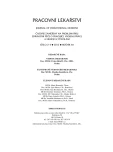Evidence of occupational exposure to genotoxic factors in Moravia-Silesia region
Authors:
I. Závacká 1; P. Ambroz 2; V. Janout 2; H. Lehocká 3
Authors‘ workplace:
Katedra biomedicínských oborů, Lékařská fakulta OU v Ostravě, vedoucí doc. RNDr. Kristián Šafarčík, Ph. D.
1; Ústav epidemiologie a ochrany veřejného zdraví, Lékařská fakulta OU v Ostravě, vedoucí prof. MUDr. Vladimír Janout, CSc.
2; Oddělení fyziologie práce, Zdravotní ústav se sídlem v Ostravě, Lékařská fakulta OU v Ostravě, vedoucí MUDr. Hana Lehocká, Ph. D.
3
Published in:
Pracov. Lék., 64, 2012, No. 2-3, s. 86-91.
Category:
Original Papers
Overview
The objective of the work was to describe and analyze data kept in the files of the registry of occupational exposure to genotoxic factors within the Moravia-Silesia region. We selected 748 persons whose data were kept in the registry since 2005 for at least three years, mostly in the exposure to genotoxic factors of chemical nature. The mean duration of exposure was 15.1 years. Cytogenetic analysis of human peripheral lymphocytes was performed 492 subjects out of the 748 individuals. The group of increased and high exposure to genotoxic factors included 341 persons. The results indicate an increase exposure to genotoxic factors and thereby increased probability in development of tumor diseases. The persons whose values of percentage of aberrant cells had been repeatedly elevated were subsequently laid off the exposure and often also excluded from the register. Moreover, persons who died or were laid off the job were also excluded from the register. In this way, regular follow up was disrupted at the time, when there is the highest possibility that the biological effect of long-term exposure to genotoxic substances becomes manifest due to latency period the provision of preventive care was also disrupted.
Key words:
genotoxic risk – register – occupational exposure – cytogenetic analysis of human peripheral lymphocytes
Sources
1. BONASSI, S., ABBONDANDOLO, A., CAMURRI, L. et al. Are chromosome aberrations in circulating lymphocytes predictive of future cancer onset in humans? Preliminary results of an Italian cohort study. Cancer Genet. Cytogenet., 1995, 79, s. 133–135.
2. BONASSI, S., HAGMAR, L., STRÖMBERG, U. et al. Chromosomal aberrations in lymphocytes predict human cancer independently of exposure to carcinogens. European Study Group on Cytogenetic Biomarkers and Health. Cancer Res., 2000, 60, č. 6, s. 1619–1625.
3. BROGGER, A., HAGMAR, L., HANSTEEN, I. L. et al. An inter-Nordic prospective study on cytogenetic endpoints and cancer risk: Nordic Study Group on the Health Risk of Chromosome Damage. Cancer Genet. Cytogenet., 1990, 45, s. 85–92.
4. BUCHANCOVÁ, J. et al. Pracovné lekárstvo a toxikológia. Martin, Osveta, 2003, s. 90–118, ISBN 80-8063-113-1.
5. DOBIÁŠ, L., JIRÁK, Z., VÍT, M. Hygiena práce – Chemické látky v životním a pracovním prostředí. VŠB, Ostrava, 1995, s. 15–44.
6. HAGMAR, L., BONASSI, S., STRÖMBERG, U., BROGGER, A., KNUDSEN, L., NORPPA, H., REUTERWALL, C. Chromosomal aberrations in lymphocytes predict human cancer: a report from the European Study Group on Cytogenetic Biomarkers and Health (ESCH). Cancer Res. 1998a, 58, s. 4117–4121.
7. HAGMAR, L., BONASSI, S., STRÖMBERG, U. et.al. Cancer predictive value of cytogenetic markers used in occupational health surveillance programs: a report from an ongoing study by the European Study Group on Cytogenetic Biomarkers and Health. Mutat. Res., 1998b, 405, s.171–178.
8. HAGMAR, L., BROGGER, A., HANSTEEN, I. L. et al.Cancer risk in humans predicted by increased levels of chromosome aberrations in lymphocytes: Nordic Study Group on the Health Risk of Chromosome Damage. Cancer Res., 1994, 54, s. 2919–2922.
9. LIOU, S. H., LUNG, J. C., CHEN, Y. H., YANG, T., HSIEH, L. L., CHEN C. J., WU, T. N. Increased chromosome-type chromosome aberration frequencies as biomarkers of cancer risk in a blackfoot endemic area. Cancer Res., 1999, 59, s. 1481–1484.
10. Nařízení vlády č. 68/2010 Sb. v platném znění, kterým se mění nařízení vlády č. 361/2007 Sb., kterým se stanoví podmínky ochrany zdraví při práci.
11. RÖSSNER, P. Využití cytogenetické analýzy periferních lymfocytů pro hodnocení expozice genotoxickým látkám v prostředí. Praha, 2004, PhD. Thesis. Státní zdravotní ústav
12. SZÚ. Zdravotní rizika pracovních podmínek a jejich důsledky. In Systém monitorování zdravotního stavu obyvatelstva ve vztahu k životnímu prostředí – subsystém 7, Odborná zpráva za období 2000 – 2004. Praha 2005, s. 48, ISBN 80-7071-261-9.
13. ŠMERHLOVSKÝ, Z., LANDA, K., VAVŘINOVÁ, J., CIKRT, M. REGEX – potencionální zdravotní dopady profesionální expozice karcinogenům. In Sborník XXXI. Pachnerovy dny pracovního lékařství, Rožnov pod Radhoštěm, 2006, s. 11–12.
14. ŠVÁBOVÁ, K., ZNOJEMSKÁ, S. Nádory a povolání. Čes. pracov. Lék., 2006, 7, 1, 2006, s. 9–11.
15. TAIOLI, E., BONASSI, S. Methodological issues in pooled analysis of biomarker studies. Mutat. Res., 2002, Vol. 512, č. 1, s. 85–92.
16. VAVŘINOVÁ, J. Podpora zdraví na pracovišti – nový úkol pro pracovní lékaře. Čes. pracov. Lék., 2004, 5, č. 3, s. 123–125.
17. Vyhláška MZ ČR 288/2003 Sb., kterou se stanoví práce a pracoviště, které jsou zakázány těhotným ženám, kojícím ženám, matkám do konce devátého měsíce po porodu, mladistvým, a podmínky, za nichž mohou mladiství výjimečně tyto práce konat z důvodu přípravy na povolání.
Labels
Hygiene and epidemiology Hyperbaric medicine Occupational medicineArticle was published in
Occupational Medicine

2012 Issue 2-3
Most read in this issue
- Silicosis and coal workers’ pneumoconiosis in Slovakia in the years 1981–2010
- Psychological resistance and subjectively perceived distress in persons occupationally exposed to stressful situations
- System enzyme therapy as a possibility of conservative treatment of the carpal tunnel syndrome – a pilot study
- Analyzing clinical symptoms of the synergy of high exposure to noise and vibration on human health in productions
